The LHC dishes up hot dense matter at higher energies than ever before.
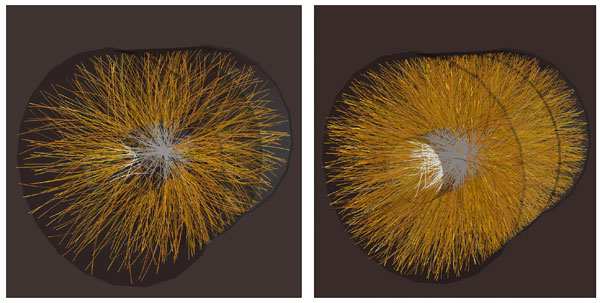
The goal of ALICE (A Large Ion Collider Experiment) is to measure the properties of strongly interacting matter generated in heavy-ion collisions at the LHC at CERN. On 7 November 2010, the LHC became the world’s most energetic heavy-ion accelerator when lead nuclei collided at a centre-of-mass energy √(sNN) = 2.76 TeV per colliding nucleon pair. This is an energy more than 10 times higher than that of the previous record holder, the Relativistic Heavy-Ion Collider (RHIC) at Brookhaven National Laboratory in New York.
Quantum chromodynamics (QCD), the theory of strong interactions, predicts that at a temperature of about 170 MeV (2 × 1012 K), nuclear matter undergoes a phase transition from its normal hadronic state to a deconfined partonic phase, the quark-gluon plasma (QGP). This is about 100,000 times hotter than the core of the Sun, and such extreme conditions occur only under special circumstances. One such circumstance is the early universe, where the QGP filled all space a few microseconds after the Big Bang; another is the head-on collision of heavy ions at the LHC and RHIC, where a QGP may be created for a fleeting instant.
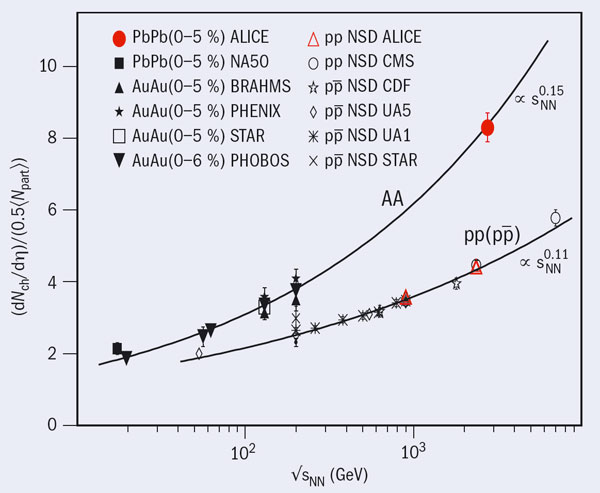
RHIC has now been running for a decade. One of its spectacular findings was that the matter generated in heavy-ion collisions flows like a liquid with very low internal resistance to flow, almost at the limit of what is allowed for any material in nature. This tells us that the constituents of this matter are quite different from freely interacting quarks and gluons. This almost-perfect fluid has been found to be opaque to even the most energetic partons (quarks and gluons), which appear as “jets” of particles from the collisions – an effect known as jet quenching. The physical mechanisms underlying these phenomena are not well understood. One of the first tasks of heavy-ion studies at the LHC is to “rediscover” these effects and probe them further with new tools as the basis for a much broader and deeper study of the QGP in the coming years. So what have we learnt at the LHC from heavy ions so far?
“Calibrating” at the LHC
To explore the features of hot QCD matter we have to calibrate our tools. Interpretation of the complex interaction of heavy-ions relies on theoretical modelling, beginning with the initial conditions of the hot system – the fireball – at the instant after the collision. One of the crucial inputs for calibrating the models is the distribution of the multiplicity (total number) of particles produced in a collision. This tells us a great deal about how the quarks and gluons in the incoming nuclei transform into the particles (pions, kaons, and so on) observed in the detector.

The number of generated particles is correlated with the impact parameter of the collision; that is, the distance between centres of the colliding nuclei. Small impact parameters, in which the colliding nuclei hit each other nearly head-on so that the largest number of incoming protons and neutrons “participate” in the collision, generate the most particles. Thus, ordering the ensemble of measured collisions according to their multiplicity allows them to be sorted into different classes of impact parameter. The number of created particles can also tell us about the energy density reached within the collisions and the temperature of the fireball.
Multiplicity measurements by the ALICE experiment show that the system created at the LHC initially has much higher energy density and is at least 30% hotter than at RHIC, resulting in about double the particle multiplicity for each colliding nucleon pair (Aamodt et al. 2010a). Figure 1 shows the energy dependence of particle production with the new measurement obtained at the LHC.
Perhaps surprisingly, despite their vastly different collision energies, the growth in particle multiplicity from RHIC to the LHC is similar at all impact parameters, as figure 2 shows (Aamodt et al. 2011). These measurements by ALICE also show that various predictions driven either by phenomenological extrapolation from the lower energies or by colour-charge density-saturation models are inadequate at the LHC.
A perfect liquid at the LHC?
Off-centre nuclear collisions, with a finite impact parameter, create a strongly asymmetric “almond-shaped” fireball. However, experiments cannot measure the spatial dimensions of the interaction (except in special cases, for example in the production of pions). Instead, they measure the momentum distributions of the emitted particles. A correlation between the measured azimuthal momentum distribution of particles emitted from the decaying fireball and the initial spatial asymmetry can arise only from multiple interactions between the constituents of the created matter; in other words it tells us about how the matter flows, which is related to its equation of state and its thermodynamic transport properties.
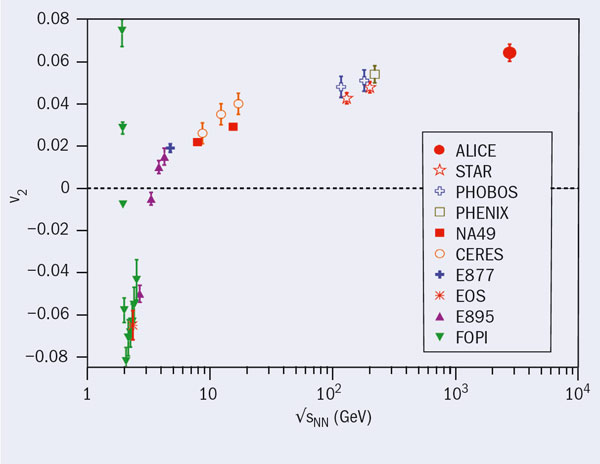
The measured azimuthal distribution of particles in momentum space can be decomposed into Fourier coefficients. The second Fourier coefficient (v2), called elliptic flow, is particularly sensitive to the internal friction or viscosity of the fluid, or more precisely, η/s, the ratio of the shear viscosity (η) to entropy (s) of the system. For a good fluid such as water, the η/s ratio is small. A “thick” liquid, such as honey, has large values of η/s. Comparison of the elliptic flow measured in heavy-ion collisions at RHIC with theoretical models suggests that the hot matter created in the collision flows like a fluid with little friction, with η/s close to its lower limit – the theoretical limit for a perfect fluid limit – given by η/s = ħ/4πkB, where ħ is Planck’s constant and kB is the Boltzmann constant.
In heavy-ion collisions at the LHC, the ALICE collaboration found that the elliptic flow of charged particles increases by about 30% compared with flow measured at the highest energy at RHIC of 0.2 TeV (figure 3). However, hydrodynamic calculations tuned to reproduce the results at RHIC – when recalibrated to the LHC energy regime – reproduce the new measurements well. The hot and dense matter at the LHC also behaves like a fluid with almost zero viscosity. With these measurements, ALICE has just begun to explore the temperature dependence of η/s and we anticipate many more in-depth flow-related measurements at the LHC that will constrain the hydrodynamic features of the QGP even further.
Partonic energy loss
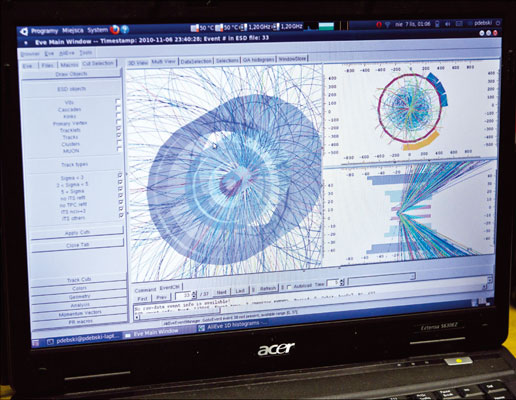
A basic process in QCD is the energy loss of a fast parton in a medium composed of colour charges. This phenomenon, “jet quenching”, is especially useful in the study of the QGP, using the naturally occurring products (jets) of the hard scattering of quarks and gluons from the incoming nuclei. A highly energetic parton (a colour charge) probes the coloured medium rather like an X-ray probes ordinary matter. The production of these partonic probes in hadronic collisions is well understood within perturbative QCD. The theory also shows that a parton traversing the medium will lose a fraction of its energy in emitting many soft (low energy) gluons. The amount of the radiated energy is proportional to the density of the medium and to the square of the path length travelled by the parton in the medium. Theory also predicts that the energy loss depends on the flavour of the parton.
Jet quenching was first observed at RHIC by measuring the yields of hadrons with high transverse momentum (pT). These particles are produced via fragmentation of energetic partons. The yields of these high-pT particles in central nucleus–nucleus collisions were found to be a factor of five lower than expected from the measurements in proton–proton reactions. ALICE has recently published the measurement of charged particles in central heavy-ion collisions at the LHC. As at RHIC, the production of high-pT hadrons at the LHC is strongly suppressed. However, the observations at the LHC show qualitatively new features (see box). The observation from ALICE is consistent with reports from the ATLAS and CMS collaborations on direct evidence for parton energy loss within heavy-ion collisions using fully reconstructed back-to-back jets of particles associated with hard parton scatterings. The latter two experiments have shown a strong energy imbalance between the jet and its recoiling partner (G Aad et al. 2010 and CMS collaboration 2011). This imbalance is thought to arise because one of the jets traversed the hot and dense matter, transferring a substantial fraction of its energy to the medium in a way that is not recovered by the reconstruction of the jets.
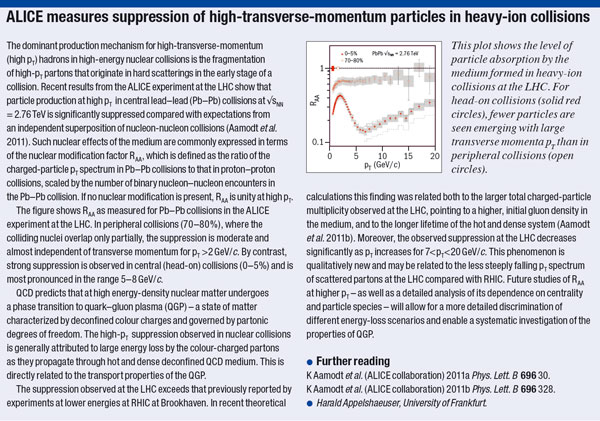
With the first findings on hydrodynamic features of the medium created at the LHC and its opaqueness to energetic partons, the LHC has, to a large extent, reproduced measurements at RHIC. The measurements at the LHC will, however, profit from the denser medium and its longer lifetime. The vast kinematic reach provided by the higher-energy collision system enables qualitatively new measurements of the QGP.
On 23–28 May, Quark Matter, a key conference in heavy-ion physics, takes place in Annecy. The most recent experimental results and theoretical state-of-the-art concepts and calculations will be presented, targeted at the detailed understanding of QGP at RHIC and at the LHC. The ALICE collaboration will report on the observations discussed here and will also present new, in-depth studies of the elliptic flow with respect to the type of particle and its mass. Also, the first studies addressing the interplay between collective features of the medium and jet production at the LHC will be shown. Moreover, ALICE will present its first insight into the energy loss of heavy flavour (charm and bottom quarks) in the hot QCD medium. In the coming years, all of these crucial measurements will help to uncover the key properties of the QGP at the LHC.





